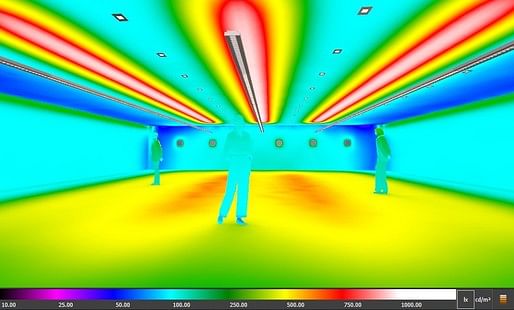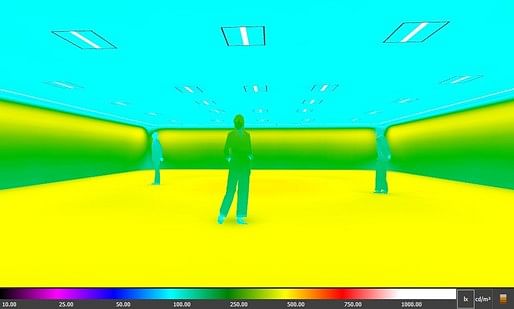
In this post, i will make an attempt to capture the evolution of lighting schemes from room based lighting to the contemporary, task based and 'non-visual' aspects of lighting schemes. 
While, the horizontal lighting levels are still the primary consideration, impact of light on our perceptions and biological functions, as a stimulus, has forced us to look at additional factors, like, modelling, mean cylindrical illuminance, color temperatures, light color, directional aspects of light etc. When all these factors are in an optimum balance, productivity and motivational levels of occupants have improved.
Let us consider a hypothetical case of a room of 15mx15mx2.8m with a reflectance factor of 0.7,0.5 and 0.2 for Ceiling, Walls and floor respectively . Obviously, there would be columns, windows, doors etc which would impact the lighting scheme. But for simplicity and comparison, let us consider this example.
Those days (90s), various types of metal reflectors were used to push light as efficiently as possible to the workplane. Fluorescent lamps were the main source of light and CFL downlights had just arrived on the scene.



The disadvantages with this directional-only lighting scheme were:
- A "cave effect" with the top of the walls and the ceiling, in relation to the workplane were dark, creating a gloomy and lazy workplace.
- Harsh shadows from eyebrows and nose because of the intense directional lighting under the luminaires produced unpleasant facial expressions, which did not aid personal communication.
- Conical or square 'frustum' of light distribution would be placed at the maximum spacing that the uniformity above the workplane, i.e at the face level, 1.2m for sitting and 1.6m for standing, was very poor.
- These can be observed on Antoine (model on the left), where the lighting gradient is fading from top to bottom, as he is directly under a luminaire. But, the lighting gradient is fading from bottom to top, on Alice (middle) and Sarah (right), as they are standing in between luminaires. The light is coming down with such high pressure that it manages to bounce off a poor (0.2) reflectance surface to considerable heights.
When 36W CFLs came in to the market, they started replacing the 4x18W Fluorescent tubes. But the directional aspect of the luminaires remained downward.
When the benefits of brighter ceilings became clear with scientific research, CFL lamps enabled the development of direct/indirect luminaires, which improved the diffuse component of lighting at face levels.
Then came T5 lamps which pushed this direct/indirect luminaire development further.
But, no technology changed the lighting concept, as the invention of LED. Moreover, it coincided greatly with our new understanding about, light as a stimulus, on our perceptions and biological functions.
Initially, LEDs were used for accent lighting and cove lighting. Immense potential of miniaturized light source, digital nature, ease of control of color and intensity, long life time attracted huge interest and investments which accelerated the progress in LED optics, thermal management and control drivers.
LED systems provided the perfect opportunity to achieve a balance between the directional and diffuse aspects of light.



For the first time, we were able to achieve the target lighting levels with lesser consumption and better lighting quality. In our example, we have achieved 33% better efficiency, but more importantly, a better visual field on the vertical surfaces.
Further developments led to a bevy of choices of wattages, intensities and sizes of LED that enabled us to have layers of lighting levels.



Vertical surfaces could be highlighted much more efficiently with this layered approach. We are still below the original consumption levels of 31kWh/a/sq.m, in the above example. But look at the drastic improvement on the vertical surfaces!
Because of this layered approach, we had the ability to optimize the typical matrix layout.



Unless, we compare the plan of the layout, it is difficult to find the subtle variation in the layout. There is no perceptible lighting quality difference, even with reduction of few luminaires!
Alongside this, there was a spurt of organically flowing architecture in both interiors and exteriors. This meant a continuous line of light, rather than any directional aspect, which could disrupt the flowing character.



Occasionally, pattern, or lighting accents were introduced to break the monotonous and diffuse nature of the lighting scheme.


Following these technological progress and research findings, standards started promoting visual efficacy in addition to energy efficiency, more actively. Terminologies such as biologically effective lighting, modelling, mean cylindrical illuminance, vertical surfaces etc became more prominent.
From room based lighting schemes, task based lighting schemes with task area, immediate surrounding area and background area became more popular. This enhanced the energy saving potential drastically.
In the same room, if we had an aisle in the center, we had the option to treat the areas separately instead of the entire room as one entity. This enhanced the way finding and orientation in interior spaces.



As you can imagine, the balance between the directional and diffuse aspects of lighting, modelling, were greatly enhanced with this approach.
An indicator of modelling, being, the ratio of cylindrical illuminance and horizontal illuminance at a point, improved drastically.
Obviously, lighting design software greatly enabled these iterations, without which optimizing these factors would have been impossible.
Suppose the aisles are on either side instead of the center, then a different scheme was possible.


The lighting consumption is getting optimized, modelling is getting optimized, uniformity is getting optimized, visual ambiance is getting enhanced improving the motivation and inspiration in a workplace, personal communications are getting optimized as workplaces are becoming knowledge factories.
Slowly, the impact of light colors on our moods and emotions are being recognized and have started slowly trickling in to our designs.


While, the colored lights, direction of lights, color temperature variations, modelling, intensity variations, mean cylindrical illuminance, etc, might not contribute to the visual functions, they contribute immensely to the non-visual biological functions, which greatly enhance our mood, emotions, general well being and productivity.
Any workplace, which depends on interaction, cooperation, communication and team work, for success would greatly benefit from giving importance to these quality parameters!
What do you think? Share your comments below.
___ ___ ___
I aim to spread awareness on the subject of Healthy Lighting designs to facilitate co-creation of healthy lighting at home, work and other social spaces. My posts can be accessed at Archinect and Linkedin Group. I also have a self published book "Healthy Lighting of your Homes" at Amazon.
This blog would attempt to cover basic design factors typically considered in lighting design. In 1998, i was asked about the material of the filament inside the incandescent bulb, for which i did not have a clue, at that time. I am an engineer and i have the aptitude to learn the subject is what i told the interviewer and surprisingly, got into the lighting industry! Perhaps it is that shameful ignorance that gave me a voracious appetite to proactively seek, learn and understand lighting.
No Comments
Block this user
Are you sure you want to block this user and hide all related comments throughout the site?
Archinect
This is your first comment on Archinect. Your comment will be visible once approved.